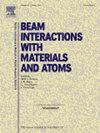Study of changes in surface composition and morphology of GaAs irradiated with different energies protons
IF 1.4
3区 物理与天体物理
Q3 INSTRUMENTS & INSTRUMENTATION
Nuclear Instruments & Methods in Physics Research Section B-beam Interactions With Materials and Atoms
Pub Date : 2025-01-06
DOI:10.1016/j.nimb.2024.165609
引用次数: 0
Abstract
Gallium arsenide (GaAs) is a direct bandgap semiconductor material known for its excellent radiation resistance. This study investigates the radiation effects on both intrinsic GaAs and n-type GaAs. The samples were irradiated with 100 keV and 2 MeV protons at fluence ranging from 6 × 1014p/cm2 to 1 × 1016p/cm2. The chemical components and surface morphology were characterized by X-ray Photoelectron Spectroscopy (XPS) and Atomic Force Microscopy (AFM). The XPS results show that proton irradiation changed the chemical composition of the GaAs surface. AFM analysis revealed that proton irradiation induced the formation of hillocks and craters on the GaAs surface, which further merged with increasing fluence. Notably, the surface damage resulting from 100 keV proton irradiation was more severe than that caused by 2 MeV protons. Compared to intrinsic GaAs, n-type GaAs exhibits worse radiation resistance of structural stability.
不同能量质子辐照砷化镓表面组成及形貌变化的研究
砷化镓(GaAs)是一种直接带隙半导体材料,具有优异的抗辐射性能。本文研究了辐射对本征砷化镓和n型砷化镓的影响。用100 keV和2 MeV质子辐照样品,辐照量从6 × 1014p/cm2到1 × 1016p/cm2不等。利用x射线光电子能谱(XPS)和原子力显微镜(AFM)对其化学成分和表面形貌进行了表征。XPS结果表明,质子辐照改变了GaAs表面的化学成分。原子力显微镜(AFM)分析表明,质子辐照诱导GaAs表面形成丘状和坑状结构,随着辐照量的增加,丘状和坑状结构进一步合并。值得注意的是,100 keV质子辐照造成的表面损伤比2 MeV质子辐照造成的表面损伤更严重。与本征砷化镓相比,n型砷化镓具有较差的抗辐射结构稳定性。
本文章由计算机程序翻译,如有差异,请以英文原文为准。
求助全文
约1分钟内获得全文
求助全文
来源期刊
CiteScore
2.80
自引率
7.70%
发文量
231
审稿时长
1.9 months
期刊介绍:
Section B of Nuclear Instruments and Methods in Physics Research covers all aspects of the interaction of energetic beams with atoms, molecules and aggregate forms of matter. This includes ion beam analysis and ion beam modification of materials as well as basic data of importance for these studies. Topics of general interest include: atomic collisions in solids, particle channelling, all aspects of collision cascades, the modification of materials by energetic beams, ion implantation, irradiation - induced changes in materials, the physics and chemistry of beam interactions and the analysis of materials by all forms of energetic radiation. Modification by ion, laser and electron beams for the study of electronic materials, metals, ceramics, insulators, polymers and other important and new materials systems are included. Related studies, such as the application of ion beam analysis to biological, archaeological and geological samples as well as applications to solve problems in planetary science are also welcome. Energetic beams of interest include atomic and molecular ions, neutrons, positrons and muons, plasmas directed at surfaces, electron and photon beams, including laser treated surfaces and studies of solids by photon radiation from rotating anodes, synchrotrons, etc. In addition, the interaction between various forms of radiation and radiation-induced deposition processes are relevant.

 求助内容:
求助内容: 应助结果提醒方式:
应助结果提醒方式:


